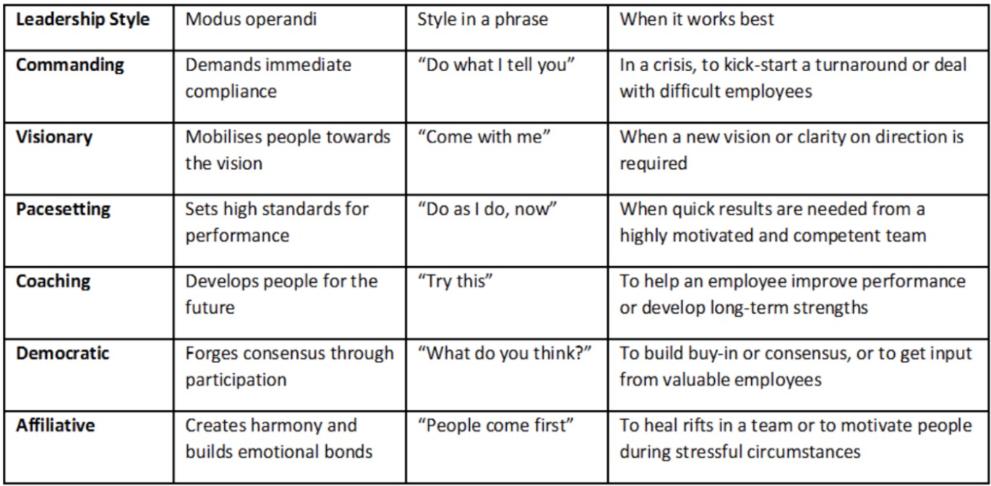Middle Leadership Blog Series Theory Post 3
Selecting Goleman's leadership styles

Who is this blog post for: Current or emerging middle leaders and for senior leaders or Headteachers who are developing middle leaders.
Author: Lisa Ramshaw
Posted on: 14th November 2023
Keywords: Emotional intelligence; leadership styles; situation-specific; toolbox.
Goleman’s Leadership Styles
Do you play golf, enjoy cooking, or perhaps you’re handy with DIY?
With any of those examples, you know you need to select the right club, utensil, or tool to be able to achieve the right outcome. Using leadership styles effectively works on the same principle.
In 2000, Daniel Goleman wrote an article for the Harvard Business Review entitled ‘Leadership That Gets Results’, explaining six emotional leadership styles: Commanding (or Coercive); Visionary (or Authoritative); Pacesetting; Coaching; Democratic; and Affiliative. These are summarised in the table below.

The article identified that the most effective leaders use a collection of leadership styles, each in the right measure, at just the right time.
Reflection
|
Each style tends to have pros and cons, as there is no one style that is the ‘silver bullet’. However, if some styles are overused, or used to their extreme, they can be quite damaging to an individual, or to the organisational culture. Let’s take commanding style for example. If people need a top-down decision or for the leader to take charge, then this style is effective for providing confidence and direction. However, when used to try and get everyone to conform, this can create resistance, low morale, and discourage people. For that reason, commanding style is most likely used in the shorter-term, as longer-term use can create dissonance. Similarly, the pacesetting style should be used with caution. No doubt you are a middle leader because you were great at teaching, and you have shown high expectations and achievement within your career so far. Often, these high expectations and drive follow you into your leadership role and you expect everyone else to behave in the same way. However, all leaders have to learn that not everyone in their team will have the same priorities or drive as them. I know I learned this in the early stages of being a middle leader, when another teacher just burst into tears in front of me because I was making her anxious, of which I had no right to. When using the pacesetting style, ensure your team or the staff you are working with share the same values, goals and working patterns as you, so you can work together at pace. For those that may work differently, or they have different goals within their own roles, allow space and time to support their development. This may be when a more affiliative or coaching approach would be beneficial. These styles tend to develop greater harmony and longer-term professional development, respectively.
Recently, I have created a new module that I teach at the university called the Future of Educational Leadership. Within this module, we look at megatrends from globalisation, to digitisation, to how demographics are changing, and how we need to adjust our leadership and leadership development accordingly. In Hieker and Pringle’s (2021) book, they share a study whereby MBA students undertook their own research on Goleman’s six leadership styles and asked millennial and Gen Z undergraduates which styles they preferred. They found that millennials and Gen Z found the coercive (commanding) and pacesetting leadership style the least effective, but preferred coaching to all other leadership styles (Hieker and Pringle, 2021, p. 16). Within a school environment, you are most likely working with people from a range of demographics, generations and cultures, ranging from students, to parents, to other staff, who all have their own set of expectations, preferences and needs. As a middle leader, you therefore need to always have your set of golf clubs, kitchen utensils or tools at hand, as you are required to adapt to each situation you are faced with. Being aware of a set of leadership styles was one of the best learning moments for me as a leader, as I was able to ‘choose’ how I responded (rather than reacted) to whatever the day brought.
As stated in the previous reflection post, middle leaders move into their leadership role directly from teaching, often without acknowledgement of the different skills that are required for the role. Self-awareness is crucial here: in the busyness of a middle leadership role, it is important to engage in conscious self-reflection. Now that you have some knowledge of Goleman’s six leadership styles, I encourage you to be consciously aware when selecting a leadership style for a particular situation, and decide what right club, utensil, or tool would be the best to use. Then consciously reflect on whether it was the appropriate leadership style for that situation. If you keep doing that on a regular basis, you will be able to develop your own leadership repertoire, applying your leadership skills and styles more appropriately, and more often.
Reflection
|
Have the above reflections ready, for the next blog in this series.
References:
- Hieker, C. and Pringle, J. (2021) The Future of Leadership Development: Disruption and the Impact of Megatrends. Springer Nature.
- Goleman. D. (2000) Leadership that gets Results. In Harvard business review, 78 (2), pp. 78–90. Harvard Business School Publishing Corporation.
- Pellitteri, J. (2021) Emotional Intelligence and Leadership Styles in Education. Psychology & its Contexts/Psychologie a Její Kontexty, 12(2).
